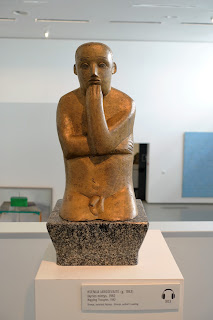Before my daughter was born, I told myself that I wasn't going to be one of those parents who tried force art and culture onto their offspring. Well, that didn't last long. I regularly take Amber to art museums, and she's developed an interest in the more traditional forms of expression, though religious depictions of saints getting tortured still bothers her. She's more sceptical of modern art, but is at least willing to give it a try. And so on a glorious (though a little chilly) Saturday afternoon we drove across the Neris to the National Art Gallery, home to a collection of Lithuanian art from the early twentieth century onwards. The building is a modernist minimalist structure from the late 1960's - this kind of architecture was apparently tolerated by Soviet authorities at least in the Baltics:
The view from the front of the museum, looking across the river:
The First Swallows by J. Mikėnas, a typical Soviet statue now in the process of being overshadowed by the forces of decadent capitalism:
Amber listens to a rant by an angry Italian feminist. A blistering criticism of dogma expressed in dogmatic terms by a dogmatist:
My daughter after discovering the crucifix on the wall to her right was made out of chocolate:
WARNING: What follows is more photos of modern Lithuanian art than I should've taken. Feel free to scroll past these in order to continue reading what happened during the rest of the weekend:
View of Kaunas from Žaliakalnis Hill (1933),Vladas Eidukevičius
Portrait of the Girl with a Box (1927), Liudomiras Slendzinkas
Woman with Fruit (1940-1), Juozas Mikėnas
Kolkhoz Founding Meeting (1950), Vincas Dilka. Rendered in dramatic Socialist Realism style.
Tractor Drivers (1965), Sofija Veiverytė
7½ Self-portraits (1972), Vincas Kisarauskas
Demonstration of the Unemployed (1965), Vincentas Gečas. Is this a depiction of something that actually occurred behind the Iron Curtain?
Scenes from Everyday Life (1950), Viktoras Petravičius
Bay II (1988), Šarūnas Sauka
Pioneer Girl (1991), Valentinas Antanavičius
Self-portrait with a Pumpkin (1977), Algimantas Švėgžda
Checking out White Composition (1978), Kazė Zimblytė
Teacher (2005), Jonas Gasiūnas. One of my daughter's favorites.
The Past (1902-3), Ferdinandas Ruščicas
Still Life with Crockery (circa 1930), Adomas Galdikas
Cubist Composition. Sitting Woman (1930), Vytautas Kairiūkštis. Obviously.
Paris (1930's), Neemija Arbitblatas
In the basement was an exhibit on pre-1940 Lithuanian female artists:
The museum has several floors-within-floors linked by short staircases, but fortunately self-operated lifts are in place which aided Amber greatly in getting around. Still, when we were finished seeing everything, she welcomed the chance to relax outside in the sunshine in the museum's cafe, drinking a Fanta and taking in the view, while trying to balance a one-cent coin on her chair's armrest:
We returned home after five, and went out again an hour later together with my art-averse spouse, as we had a reservation at an international restaurant on Stiklių gatvė in Old Town called Bistro 18. Dinner began with a sampler of three different soups, then followed by a main course of red curry, and washed down with a couple of local beers (draft, of course). My daughter and I both ended our meals with some scandalously good chocolate fondant:
Sunday was Father's Day in Lithuania. We didn't do anything paternally-related, but we did take Doering, my soon-to-be-departing supervisor at work, out to see the geographical center of Europe. Amber, Shu-E and I had visited the position at latitude 54° 54', longitude 25° 19' in mid-February, when the site was covered in snow. This time the ground was clear, and we were all given certificates to prove that we had been there. Unlike our previous visit, large mosquitoes were out in force this time:
A selfie with a typical Lithuanian cross:
We returned to Vilnius and had dinner together at Manami, an Asian restaurant located on the top floor of the Panorama shopping mall. Despite the cool evening air, we sat outside on the terrace, enjoying our meals and taking in the view:
The American Father's Day will be in two weeks' time, where if all goes to plan we'll be observing the occasion somewhere in London. I'll close this post with some random images taken this past week during my daily walks:
An abandoned building in a neighborhood south of the main train station
These little angel figures can be seen at various random locations around central Vilnius. You can read about them here and here
*Saul Bellow















































No comments:
Post a Comment